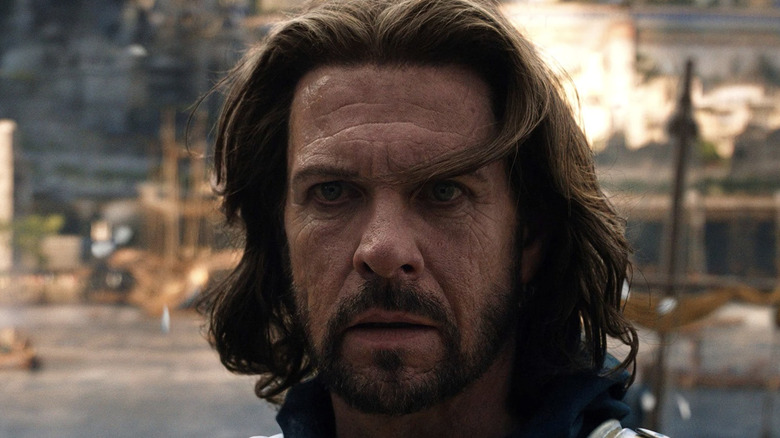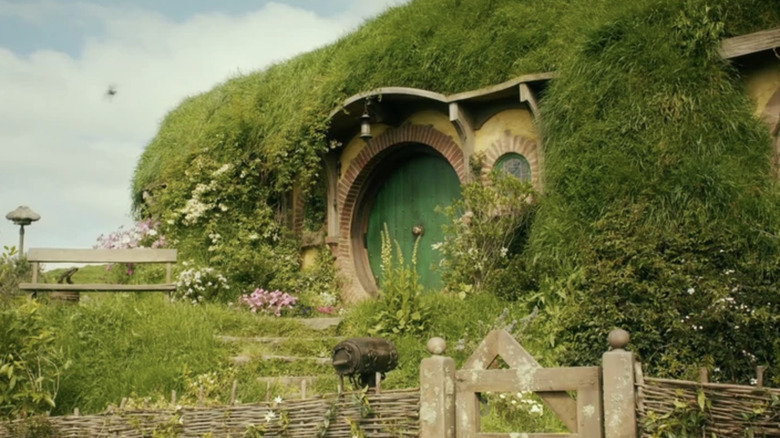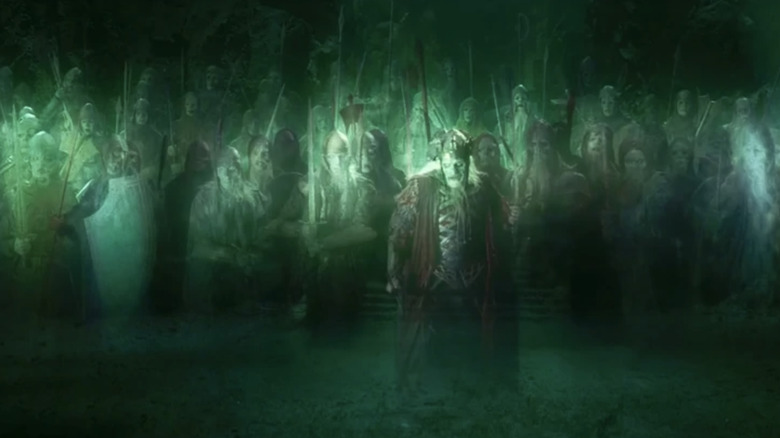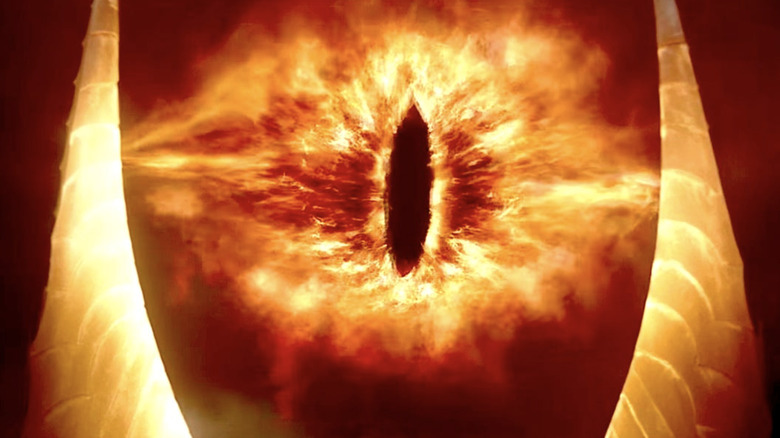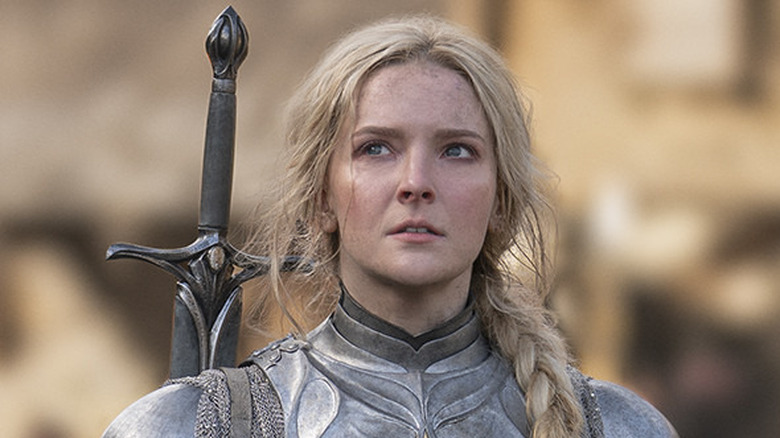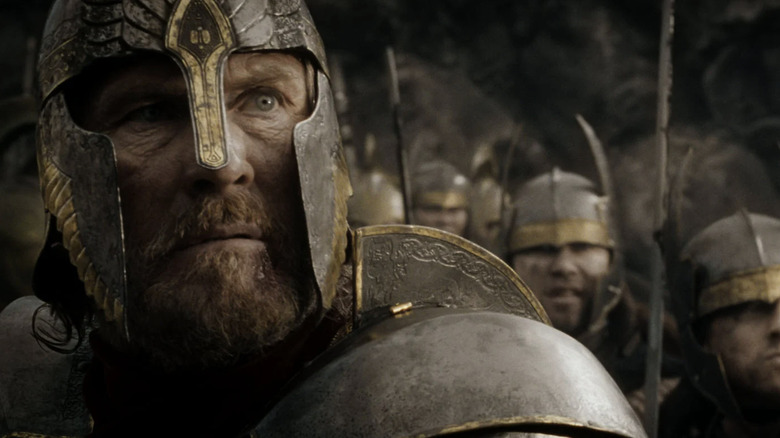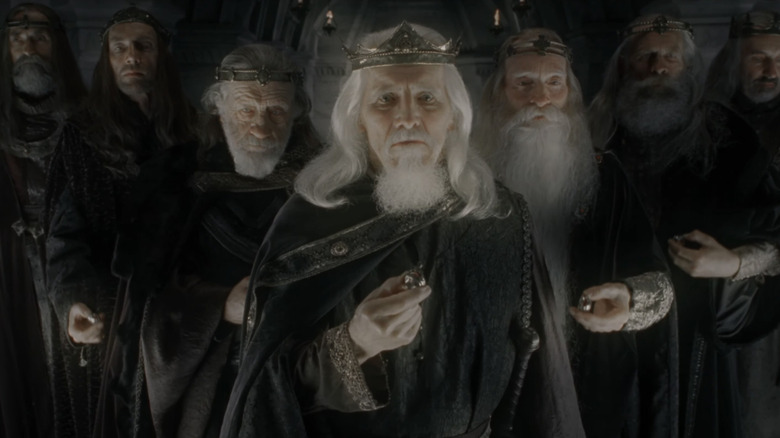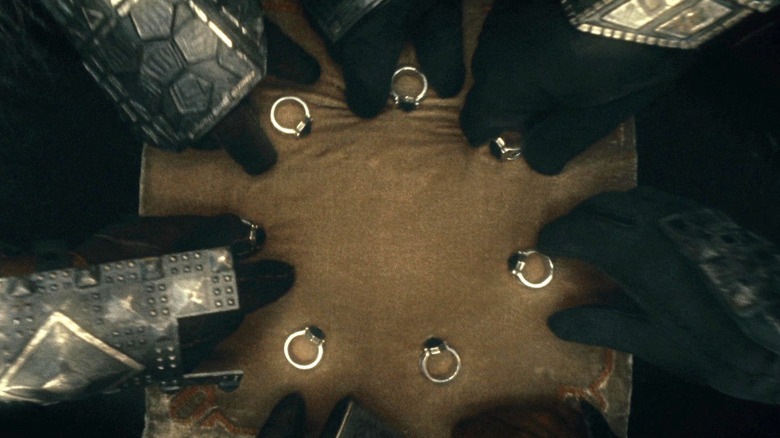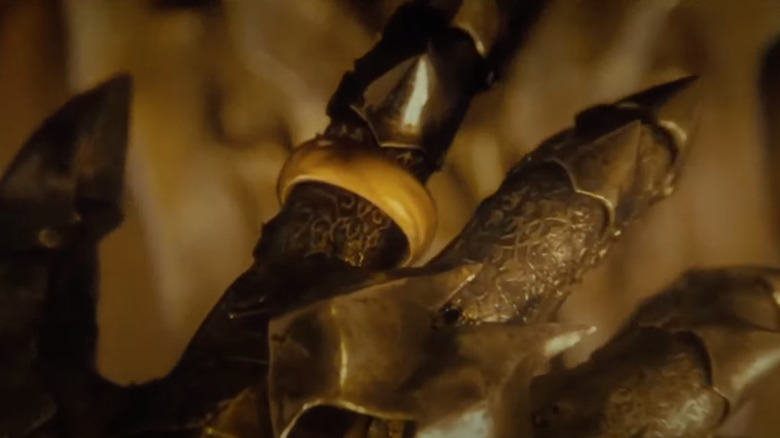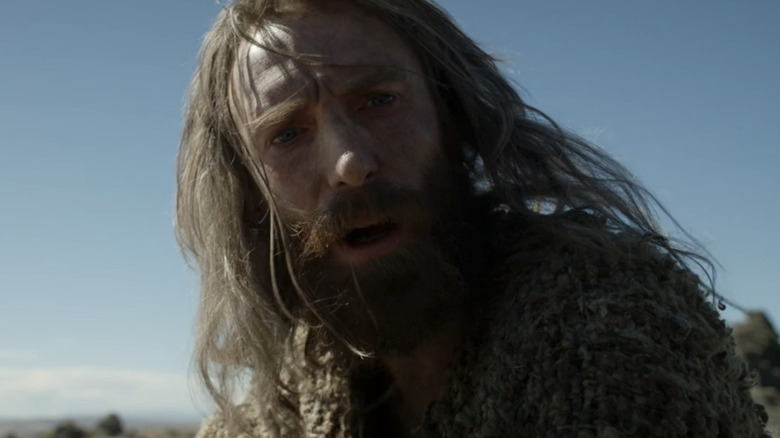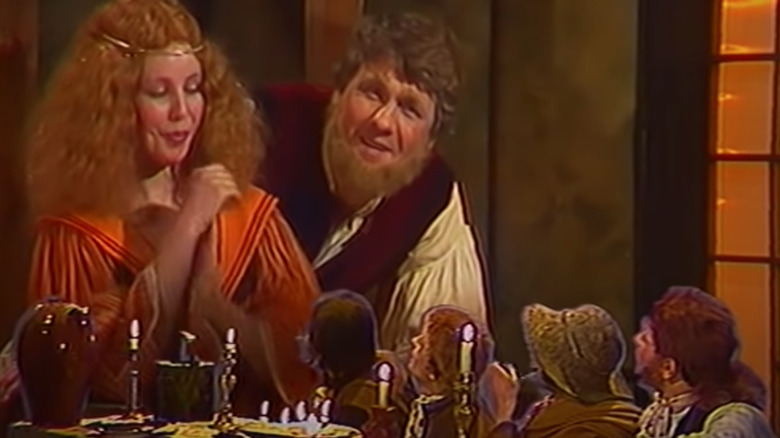Lord Of The Rings References We're Still Waiting To See In The Rings Of Power
After years of waiting, the first season of Amazon's latest hit series "The Lord of the Rings: The Rings of Power" is finally complete. With the promise of another season on the horizon, we're eagerly awaiting a return to the world of Middle-Earth. With huge plot twists and epic world-building, the first season of "The Rings of Power" was met with mixed reviews, to be sure, but there's no doubt that the series itself remains a triumph in the world of live-action, long-form fantasy.
"The Lord of the Rings" has often been described as the most epic fantasy novel series and cited as the primary inspiration for countless fantasy series such as "A Song of Ice and Fire," "Harry Potter," and "The Wheel of Time," all of which have been adapted into feature films or television series. Though the series engaged us in the events of J.R.R. Tolkien's most famous Middle-Earth stories throughout its freshman season, "The Rings of Power" missed out on a few distinct references to the initial source material on which it's based.
Here, we've chronicled some of the biggest references to "The Lord of the Rings" that, so far, "The Rings of Power" has yet to touch on. Thankfully, there's still time, and while we might not get to see everything on our Tolkien wishlists, we're hoping to see these people, places, and events as the Amazon series progresses further. Until then, here are the biggest "Lord of the Rings" references we're still waiting for.
A home for Hobbits
It doesn't take long before "The Rings of Power" introduces us to the Hobbits' ancestors, who are known as the Harfoots. As explained in Tolkien's "Fellowship of the Ring," the Harfoots were one of three tribes of smaller folk who wandered about Middle-Earth long before Hobbiton and the Shire. Darker in complexion and not quite so obsessive about creature comforts as their descendants, these nomads aren't too fond of the "taller folk" who sometimes cross their paths. "Rings of Power" characters Nori Brandyfoot, Poppy Proudfellow, and Sadoc Burrows are all Harfoots.
The Harfoot clan spent the better part of Season 1 migrating across Middle-Earth as they have yet to find a home of their own. They'll be wandering for a good while yet. According to Tolkien's lore, the Shire isn't established until the Third Age of Middle-Earth — for reference, "The Rings of Power" takes place in the Second Age — making it unlikely that we'll ever officially see it on the series, at least not outside some sort of flash-forward in time.
Regardless, the broader Hobbit culture, including Hobbit holes and a strong liking to pipe-weed, could easily begin to develop with the Harfoots on the road. Beyond that, we'd love to see the lands that may eventually become Hobbiton — the home of Frodo and Bilbo Baggins – especially if the Harfoots were to travel through them on their perilous journey. Here's hoping for more Harfoot material next season!
The Dead Men of Dunharrow
In the heat of the battle for Gondor in "The Return of the King," Aragorn arrives with an Army of the Dead at his beck and call. This undead horde helps turn the tide against Sauron's forces, allowing our heroes to overtake the evil men at their doorstep. The entire reason Aragorn is able to summon this army — led by the King of the Dead himself – is that during the War of the Last Alliance, they were called upon to help defeat Sauron then, only to abandon the Elves and Men who battled the Dark Lord.
Because of their treachery, Aragorn's ancestor Isildur cursed these men and their spirits were trapped in the mountains they once lived near. Though this kingdom of men seemingly hasn't appeared yet on "The Rings of Power," their betrayal during the Second Age would be vital for Sauron's defeat in the Third, making it a must for "The Rings of Power." Before they became the Dead Men of Dunharrow, they'd have to be allies to Elendil, Isildur, and Elrond, only to turn their backs on them before what will most likely be the final climax of the series.
While many hoped that Halbrand might turn out to be the cowardly King of the Dead, there's still room for other new characters such as Theo to take up that mantle for themselves. It's also possible that a brand new character will be introduced who might better fit the bill.
The Great Eye
From the beginning of "The Rings of Power," Sauron's symbol is a part of the story. Galadriel first finds this odd logo in his icy northern fortress, alongside other strange experiments that the fallen being was conducting. Later on, this symbol is found again in the Southlands. It's eventually revealed to be a map of the land that would soon become Mordor. While it looked a little like the famed "Eye of Sauron," it wasn't actually meant to be the logo we'd come to recognize in "The Lord of the Rings."
Though the Second Age is far too early for the giant, flaming Eye of Mordor to appear — especially given that Sauron still has a physical body at this point — that doesn't mean that the symbol of the Great Eye couldn't become a part of the Dark Lord's conquests. Many of the Orcs and Goblins that followed Sauron bore his symbol upon their armor, such that as the Fellowship traveled across Middle-Earth, they saw "The Great Eye" before they even got to Mordor.
The Eye ultimately represents Sauron's power, especially while wielding the One Ring, and is meant to strike fear into the hearts of those who would rebel against him. It would make sense if this symbol was instituted in "The Rings of Power" at some point, and would be welcomed by many Tolkien fans.
Celebrían
Now that Galadriel's longtime husband Celeborn — who is definitely not dead — has been mentioned on the show, it's time to bring back their daughter, and Elrond's future wife, Celebrían. Though this character never appeared in "The Lord of the Rings," she is a huge reason why Elrond fights to keep Arwen from marrying Aragorn. You see, Celebrían was eventually captured and tortured by Orcs, which resulted in her sailing to Valinor and leaving Middle-Earth, and her family, behind her, hoping to find peace and comfort there.
Though Elrond doesn't marry Celebrían until the Third Age, she is around and kicking during the Second, which is when they first met and he first loved her. So far on "The Rings of Power," Galadriel has played the lone "Warrior Princess" trope, but we have yet to see her family on screen. Celeborn is certainly on his way, especially given that his name has been dropped now. Celebrían will hopefully follow closely after. Given Galadriel and Elrond's friendship, there's no reason the Elf maiden wouldn't want her daughter to meet a guy like Elrond.
Though Celebrían mothered three children, including Arwen, she was the only child of Galadriel and Celeborn. Given her familial ties to Galadriel, it would be a shame if "The Rings of Power" didn't introduce her, as it would be epic to watch mother and daughter — both Ladies of Lothlórien — fight the forces of darkness side by side.
Establishing Gondor and Arnor
One of the most interesting characters in all of "The Rings of Power" is no doubt the Captain of the Númenórean Sea Guard, Elendil. A member of the Faithful, Elendil's name even means "Elf-friend" or "Star-lover." His actions surrounding the fall of Númenor and the changing of the world would prove invaluable to Middle-Earth's future, and it would be his bloodline through his son Isildur that would one day reunite the Kingdoms of Men and usher the final blow in defeating the Dark Lord Sauron in the Third Age.
Basically, Elendil — himself a descendant of Elrond's half-human brother Elros — is one of "The Rings of Power's" most interesting characters, and for good reason. One thing we're hoping to see played out on the series sooner rather than later is the Downfall of Númenor that would lead to Elendil founding and establishing the kingdoms of Gondor and Arnor, which he would rule as High King. As one of the Faithful, he'll eventually work alongside his great-great-great-something uncle Elrond against Sauron and his dark forces.
Until then, Elendil has returned to Númenor. Even in the wake of his son's apparent death, he remains true to his cause. Here's hoping that we'll continue to see Elendil's leadership skills and kingly conduct in the coming seasons.
The Nine Kings of Men
Of all the human kings in Middle-Earth, these nine were by far the worst. We don't know much about any of these men — in fact, we only know two of their names, the Witch-King of Angmar and Khamûl — but there is plenty of room to see them further explored on "The Rings of Power." Many thought that Halbrand may have become the Witch-King himself, like the King of the Dead. Given the revelation that he is in fact Sauron, the identity of the leader of the Nazgûl is still in question.
While it may not particularly matter who the Witch-King, Khamûl, and the other seven kings-turned-wraiths are to the overall "Lord of the Rings" plot, in the context of "The Rings of Power," it would make sense for the writers to give them more backstory, especially as the "Nine Rings for Mortal Men" are forged. Whether we've met these men yet or not — most likely not — it would be a fascinating tragedy to watch as these Nine Kings, who may have had the best of intentions, fall under the dark spell of Sauron.
The closest thing we've seen to the Black Riders so far may have been the Mystics who were on the hunt for Sauron this entire season, but they weren't the Nazgûl we were looking for. Here's hoping we see these Nine Kings soon, and that the power Sauron offers won't so easily corrupt them.
The other rings of power
Speaking of that power, there are still 16 Rings of Power to yet be made before the series aptly titled "The Rings of Power" may come to a conclusion. As Tolkien's legendarium goes, there were three Rings given to the Elves, which have now been forged by Celebrimbor and Elrond. But there were other rings, too. According to legend, seven would be made for the Dwarf Lords. While they wouldn't corrupt the Dwarves the same way they would Men, their greed would eventually do them in.
Of course, then there are the nine Rings of Power that would be bestowed upon the Kings of Men. These men would obviously become the Nazgûl, and would quickly become subservient to Sauron's own One Ring (more on that one next). In a series called "The Lord of the Rings: The Rings of Power," it seems likely that the rest of these Rings would become part of the series' plot, especially considering how important they are to the backdrop of "The Lord of the Rings" itself.
Without these 19 Rings, Sauron would never make his full rise to power, and we'd never get to Tolkien's classic masterwork. What will be interesting to see is how the Rings of Power affect their wearers. While we know that the Elves aren't corrupted by their Rings, the Men and Dwarves are still fair game.
One ring to rule them all
That's right, the famous One Ring has yet to make an appearance on "The Rings of Power," and while Halbrand — err, Sauron — certainly alluded to ruling all of Middle-Earth alongside Galadriel, with two Rings of Power to boot, his desire for a sole "master ring" has yet to come to fruition. Though many thought that the Dark Elf Adar or even the Stranger might turn out to be Sauron, it was revealed that Halbrand, Galadriel's friend and ally, was actually the Dark Lord in disguise.
Of course, now that he's been rejected by his would-be beloved, Sauron is now set on taking back the Southlands, aka Mordor, and reclaiming his own kingdom. How he'll do this remains to be seen, but forging a master Ring of Power to rule over the rest seems like the next logical step. Of course, the other Rings of Power must be close behind in order for it to work, but given the apparent five-season timeline the showrunners are hoping for, that shouldn't be a problem.
The most iconic object in all of Tolkien's works, the One Ring is a dark power that allowed Sauron to almost overtake Middle-Earth for himself. While the Amazon series will no doubt conclude with the Last Alliance Between Elves and Men — an epic showdown against Sauron that features Elendil, Isildur, Elrond, and their respective armies — the Dark Lord must forge his One Ring before we get there.
Tell me, where is Gandalf?
The Stranger is Gandalf, right? With a few potential reasons for making us think he's the Gray Wizard — his choices of clothing, company, and dialog among them — we have to wonder if this Istari is the Wizard we all know and love from "The Hobbit" and "The Lord of the Rings." While it may take a whole other season for us to get this answer, everyone's wondering who this mysterious character is in "The Rings of Power." At least now we know for sure that he's a member of the Istari, which is just Tolkien's word for wizards.
While there are certainly many who are hoping that the Stranger is just one of the previously unexplored Blue Wizards, which seems to make more sense now that he and Nori are headed East, there are still others hoping for a Gandalf reveal. Now, there are ways to get around calling him "Gandalf," since in Tolkien's legendarium he doesn't officially appear in Middle-Earth until the Third Age. His original name is Olórin, but he's traditionally known by many of the Elves, namely Galadriel, as Mithrandir.
Whether he's actually called Gandalf or one of his other many names on "The Rings of Power" remains to be seen. Some have even theorized that he's Saruman, but ultimately only time will tell who the Stranger actually is.
Tom Bombadil
Possibly the biggest on this list, Tom Bombadil was famously cut out of Peter Jackson's "The Lord of the Rings" trilogy, as well as all the other animated adaptations of Tolkien's signature work. While he does appear in some Tolkien-inspired video games, including some based on Jackson's film trilogy, he has never made a true live-action appearance, much to the dismay of die-hard Tolkien fans. The character, who is admittedly quite strange, is one that many hope to see brought to life at some point on "The Rings of Power."
Unlike many of the Men, Elves, Dwarves, or Istari we know from "The Lord of the Rings" and other Tolkien tales, nobody is quite sure who or what Tom Bombadil actually is. Unlike other beings, he is not particularly tempted or interested in the One Ring of Power that Frodo brings his way, and apparently existed in Tolkien's world long before the Dark Lord Morgoth fell. He's a particularly mysterious fellow who often speaks in the third person.
Tom Bombadil is a married man who lives with his wife Goldberry in the Old Forest to the east of the Shire. He has no problem defending his realm from dark forces, and can (and will) sporadically break out into dance and song. While it makes sense why Jackson felt the need to keep this mysterious stranger out of his adaptation of Tolkien's magnum opus, many are hoping that Amazon will step up to the plate and deliver a truly remarkable live-action interpretation that rivals his moments in the book. Given his apparent immortality, there's no reason he couldn't make an appearance.
